"Imagine” the “W” Wave Executive Jet Concept
I have built a model of a revolutionary new executive business jet concept I want to give to the Aerospace community. I have always enjoyed the obscure designs for high speed aircraft by people with clever minds such as this transonic air racer designed by Luigi Colani and modeled here by my British friend Big Edd Mildenhal. Photo 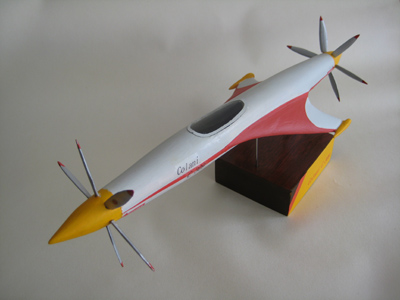 . These whimsical concepts are based on wild ideas and are neat but most are impractical to build or fly because they create more problems than they solve in stability and flight characteristics. They sure are neat looking though and really seed the minds of the creative so I love them.
. These whimsical concepts are based on wild ideas and are neat but most are impractical to build or fly because they create more problems than they solve in stability and flight characteristics. They sure are neat looking though and really seed the minds of the creative so I love them.
Aircraft have not changed much since the 1930s when they went to all metal construction. The basic cylindrical fuselage still has a pointed nose, a tail section and two wings mounted on either side of the fuselage. Going to metal as the overall construction material was the biggest change in aviation since the original airplane design of the Wright brothers in 1903. Many people think that the Burt Rutan forward canard/wings design was novel for aircraft design when it debuted in the early 1970s but the 1903 Wright flyer was of the same design of Wing and forward canard or control surfaces. The only difference was that the Rutan designs were made of composite materials.
Nowadays, with the advent of better composite materials and new and novel ways to fabricate with these materials it is time for me to unveil an all composite aircraft for the corporation that can afford to build it. If this aircraft were built of Bucky paper composite it would function 50% greater than even my calculations say it would.
The Concorde was the first supersonic airliner put into use but the fact that it needed to carry over a hundred passengers on every flight for it to almost break even in flight costs and its extremely high and always rising maintenance costs doomed the aircraft from its inception. I say “almost break even” because the entire program was essentially a money loser and only a marketing tool for the airlines which incorporated the Concorde into their fleet.
The big profit eye was more on the airline’s conventional subsonic airliner travel. The Concorde was the “Jewel” or the “come on” of the airlines that used her sort of like advertising companies use beautiful model women to sell products for their clients.
The reality is that only a very few number of people really need to cross the Atlantic Ocean at supersonic speed and those are also the kind of people that can actually afford to do so. Thus a jet of this speed potential should have been much smaller, cheaper to maintain and only carry a minimal amount of passengers while also being robust and simple. The W Wave aircraft design is based on the strength of a triangle and designed so that all loads are transmitted throughout the aircraft rather than focused on a single part of the aircraft as in current designs.
I never patent 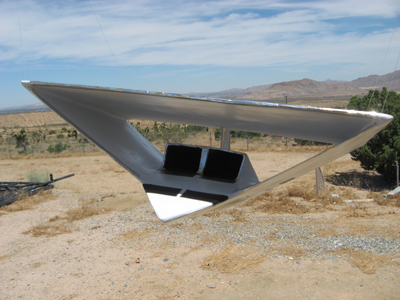 my ideas as I don’t believe one can really protect an invention from theft especially from a large corporation. The lawsuits one has to go through which can last decades and costs hundreds of thousands of dollars are a waste of time to me and I would much rather spend my time and money on something more productive than negativity, anger and selfishness. My goal has always been to seed the minds of the creative and innovative and then stand back and see what happens.
my ideas as I don’t believe one can really protect an invention from theft especially from a large corporation. The lawsuits one has to go through which can last decades and costs hundreds of thousands of dollars are a waste of time to me and I would much rather spend my time and money on something more productive than negativity, anger and selfishness. My goal has always been to seed the minds of the creative and innovative and then stand back and see what happens.
I call this new aircraft design a “W” wave supersonic executive jet. This model is named “Imagine.” It is designed to carry 8 passengers, a pilot and a copilot across the Atlantic Ocean or coast to coast at Mach 1.3.
The “W” wave supersonic aircraft concept employs some of the best ideas currently being used in modern aircraft development. It capitalizes on such fantastic and innovative concepts as the Buseman effect of slamming shock waves into other shock waves in order to cancel each other out and turn them into subsonic air pressure waves. It integrates some of the best ideas of the brilliant Dr. Croo of Stanford University and his theories on wing aerodynamics. It incorporates the use of “Blended Wing” technology as well as “lifting body” technology. It also incorporates the concept of faceting pioneered in the Stealth F-117 but in this case it is used to control shock wave direction instead of deflecting radar beams.
The Imagine “W” wave aircraft is an all composite triplane design with two of the wings pulled up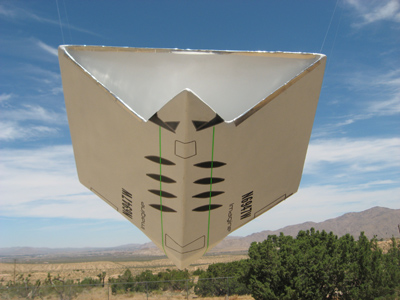 and connected to the top wing to form an inverted, leaned forward at the top triangular shape.
and connected to the top wing to form an inverted, leaned forward at the top triangular shape.
The ideas is that as this aircraft design attains transonic speeds the shocks created by the angular wings and the upper side of the fuselage form a large “W” shape and these shocks slam into the shock wave created by the underside of the much larger top wing and neutralize it even if the aircraft is in yaw or pitch as well as in level flight. Hence the name “W” wave aircraft. No the “W” does not stand for Waldo. This concept is similar to the principal used on noise canceling headphones. The then subsonic air is then sucked into the large intake scoops to feed the twin supercr uise turbofan engines. The remaining air leaves the triangular tunnel as it flows past the stabilizer at the rear of the aircraft.
The twin super cruise turbofan engines are of the same type used on the F-22, F-23, and the two joint strike fighter aircraft designs. Essentially super cruise turbofan engines are different in that they have a more advanced fuel metering system which injects just the right amount of fuel heated to just the perfect temperature to create better combustion than in older turbojet or turbofan engines. The internal components are also much lighter and lubricated more efficiently in order to save fuel and produce more power in these engines.
The wings of my W wave aircraft are large but very thin with razor sharp leading and trailing edges. This technology was perfected in the early 1950s on such aircraft as the X-1 rocket plane, F-104 Starfighter and the X-3 Stiletto. A thin sharp edged straight wing 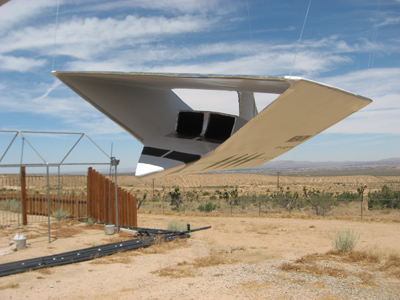 generates smaller shocks than thick wings or even thin deltas.
generates smaller shocks than thick wings or even thin deltas.
The W wave aircraft has large straight wings because they will need to carry a lot of fuel to cross the Atlantic Ocean or cross the United States coast to coast and yet they also need to generate a lot of lift. The top horizontal wing being extremely large will generate most of the lift and because of this the plane will essentially feel or handle like a Piper Cub or high wing Cessna having most of its weight hanging from the wings. The only difference is that the take off and landing speed will be in the 160 knot speed range instead of 70 or 80 knots.
The triangular shape of the fuselage and aircraft overall give the pilot and copilot excellent visibility forward and below for landing and take off and the canted out windows will give the 8 passengers a fantastic view out and below or downward. The fuselage shape being an inverted triangle with an arched roof instead of a common cylinder will also function as a lifting body at low transonic Mach numbers and a simple change of a few degrees upward in angle of attack will generate much extra lift.
The shocks created by the underside of the fuselage and the angled up wings are sent to the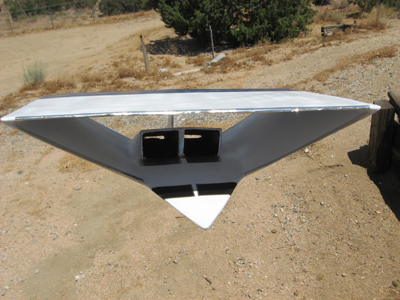 ground at an angle (that is except when the aircraft is in roll, which it would never do during supersonic cruise) and by the time the shocks strike the ground the sonic boom will be highly weakened if not non existent. The tail area is also angled up so it performs the same task of distributing the sonic shock waves farther away before they strike the ground. So this will be a supersonic aircraft that produces NO SONIC BOOMS! So in theory the W wave aircraft can fly at supersonic speeds across the country with FAA impunity.
ground at an angle (that is except when the aircraft is in roll, which it would never do during supersonic cruise) and by the time the shocks strike the ground the sonic boom will be highly weakened if not non existent. The tail area is also angled up so it performs the same task of distributing the sonic shock waves farther away before they strike the ground. So this will be a supersonic aircraft that produces NO SONIC BOOMS! So in theory the W wave aircraft can fly at supersonic speeds across the country with FAA impunity.
This design could be slightly up scaled for military applications such as a light cargo plane or small troop transport. The concept would also be applicable as a supersonic cruise missile but I hope that doesn’t happen. It would not work well as a fighter jet because of shock anomalies in the tunnel that may occur at extreme angles of attack that would overload the structure and might break the aircraft apart. No this design is best used for civilian transport.
No mater what happens in the future with the demilitarization of field propulsion power plants in the next century. The basic concept of the airplane as we know it currently using Bernoulli’s principal of generating lift while moving through the air will never go away because of its efficiency and simplicity.
airplane as we know it currently using Bernoulli’s principal of generating lift while moving through the air will never go away because of its efficiency and simplicity.
If this machine is ever built it will be able to cross the Atlantic Ocean in slightly over 3 hours or fly coast to coast in less than 3 hours at 70,000 feet. Here are the photos of the model for you all to better understand the concept. I am sure some unsavory types will claim it as their own in the near future as that has happened to me a half dozen times before. But you all in the know will remember you saw it here first and that I designed it.
I expect some of the more egotistical aerodynamicists too shoot down and criticize this design at first because they didn’t come up with it themselves. Then in the near future I will read about this new incredible aircraft concept being developed by some fantastic genius on the cover of one of those “pseudo science” magazines with names that make it sound like they actually know what they are talking about. Such is the nature of human beings and I can’t change that.
Currently I don’t have the time to devote to the construction of anything else but the construction and development of Sonic Wind LSRV. So just as on my concepts page this is a gift to those smart enough to realize it as such. If someone claims this design and calls it their own well, that won’t bother me half as much as if no one ever builds it or something very much like it. Now, that will bug the living hell out of me…... Waldo
 . These whimsical concepts are based on wild ideas and are neat but most are impractical to build or fly because they create more problems than they solve in stability and flight characteristics. They sure are neat looking though and really seed the minds of the creative so I love them.
. These whimsical concepts are based on wild ideas and are neat but most are impractical to build or fly because they create more problems than they solve in stability and flight characteristics. They sure are neat looking though and really seed the minds of the creative so I love them.
 my ideas as I don’t believe one can really protect an invention from theft especially from a large corporation. The lawsuits one has to go through which can last decades and costs hundreds of thousands of dollars are a waste of time to me and I would much rather spend my time and money on something more productive than negativity, anger and selfishness. My goal has always been to seed the minds of the creative and innovative and then stand back and see what happens.
my ideas as I don’t believe one can really protect an invention from theft especially from a large corporation. The lawsuits one has to go through which can last decades and costs hundreds of thousands of dollars are a waste of time to me and I would much rather spend my time and money on something more productive than negativity, anger and selfishness. My goal has always been to seed the minds of the creative and innovative and then stand back and see what happens. and connected to the top wing to form an inverted, leaned forward at the top triangular shape.
and connected to the top wing to form an inverted, leaned forward at the top triangular shape. generates smaller shocks than thick wings or even thin deltas.
generates smaller shocks than thick wings or even thin deltas.
 ground at an angle (that is except when the aircraft is in roll, which it would never do during supersonic cruise) and by the time the shocks strike the ground the sonic boom will be highly weakened if not non existent. The tail area is also angled up so it performs the same task of distributing the sonic shock waves farther away before they strike the ground. So this will be a supersonic aircraft that produces NO SONIC BOOMS! So in theory the W wave aircraft can fly at supersonic speeds across the country with FAA impunity.
ground at an angle (that is except when the aircraft is in roll, which it would never do during supersonic cruise) and by the time the shocks strike the ground the sonic boom will be highly weakened if not non existent. The tail area is also angled up so it performs the same task of distributing the sonic shock waves farther away before they strike the ground. So this will be a supersonic aircraft that produces NO SONIC BOOMS! So in theory the W wave aircraft can fly at supersonic speeds across the country with FAA impunity.
 airplane as we know it currently using Bernoulli’s principal of generating lift while moving through the air will never go away because of its efficiency and simplicity.
airplane as we know it currently using Bernoulli’s principal of generating lift while moving through the air will never go away because of its efficiency and simplicity.